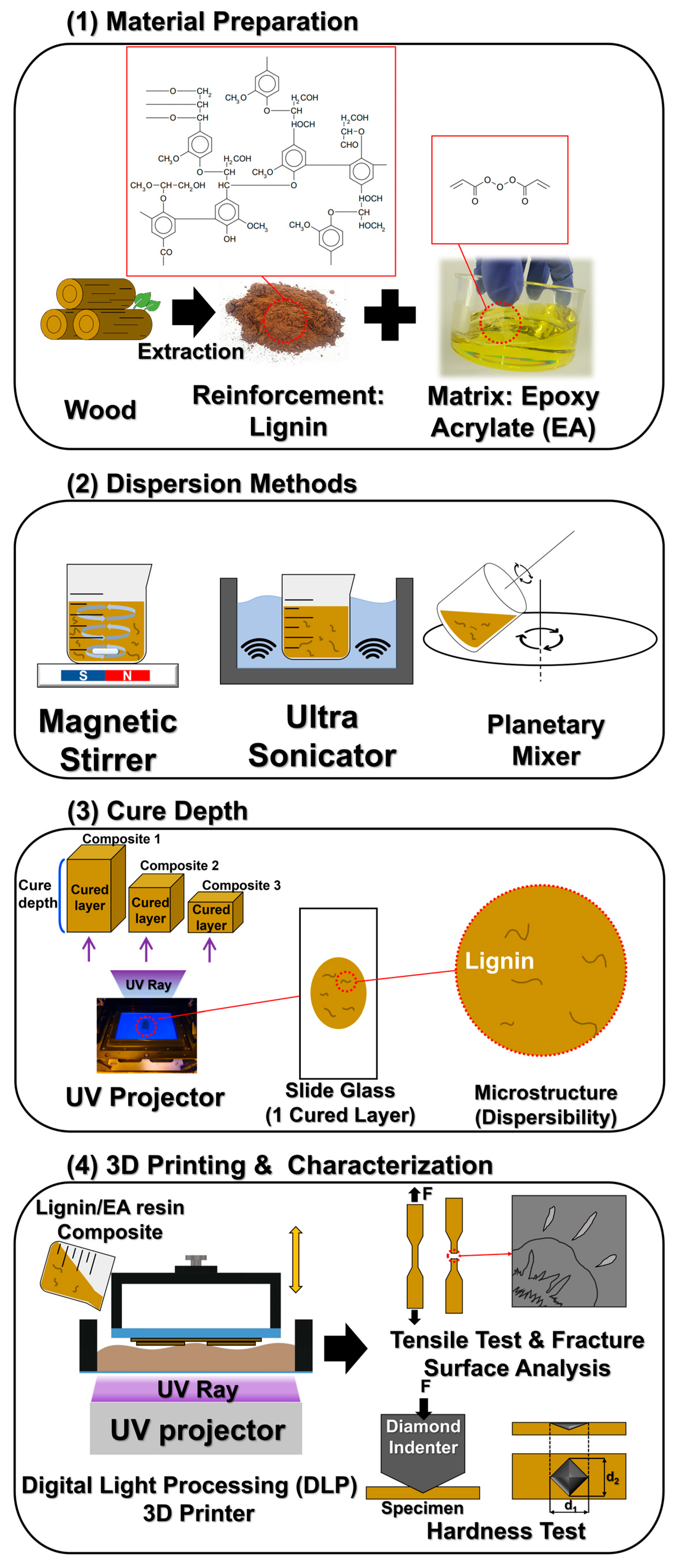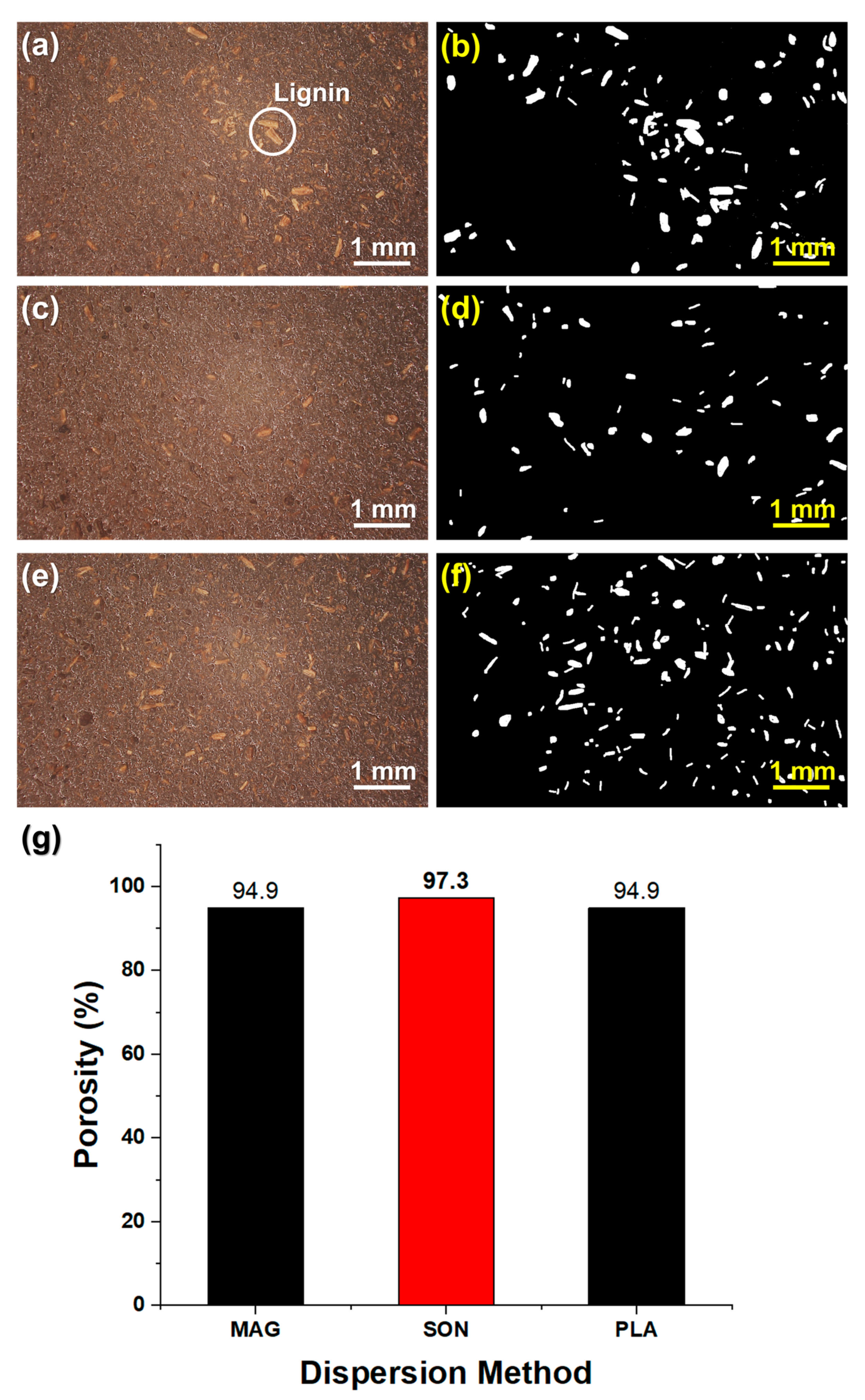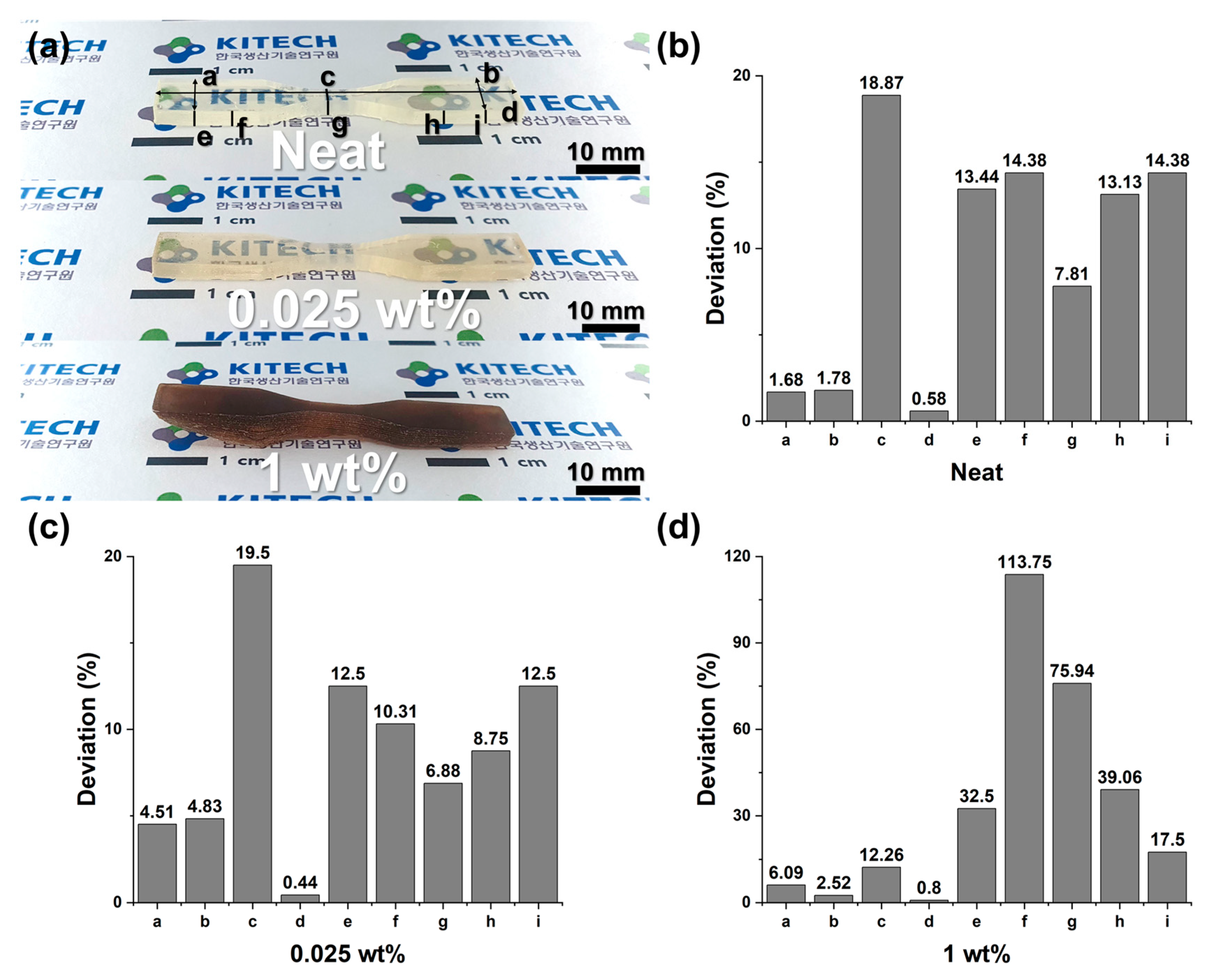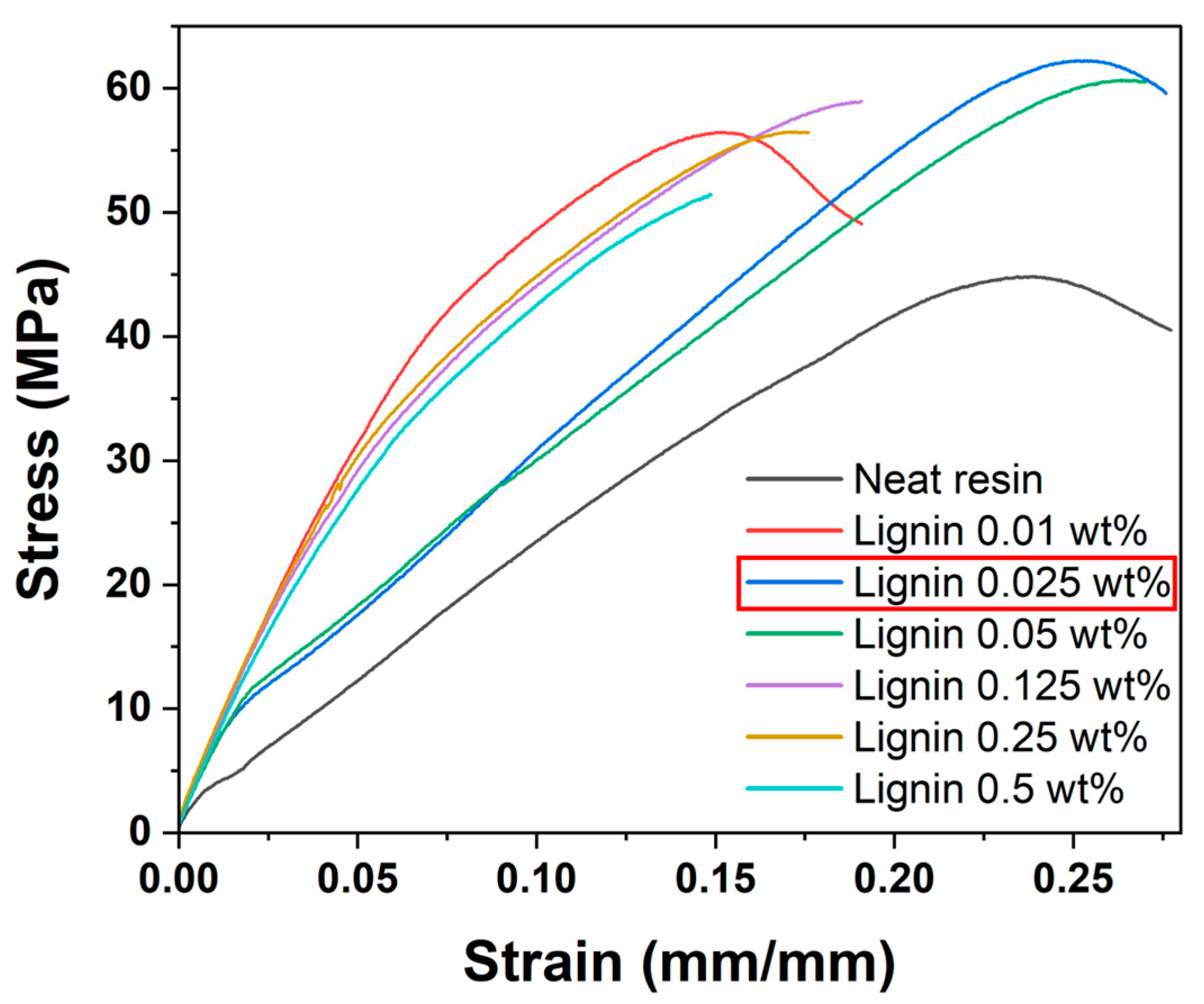Bio-Adhesive Lignin-Reinforced Epoxy Acrylate (EA)-Based Composite as a DLP 3D Printing Material
Abstract
1. Introduction
2. Materials and Methods
2.1. Material Preparation and 3D Printing
2.2. Characterization and Analysis
3. Results and Discussion
3.1. Dispersion Optimization
3.2. Printability and Dimension Reliability
3.3. Mechanical Properties of 3D Printed Specimens
4. Conclusions
Author Contributions
Funding
Institutional Review Board Statement
Data Availability Statement
Conflicts of Interest
References
- Praveena, B.A.; Lokesh, N.; Santhosh, N.; Praveena, B.L.; Vignesh, R. A comprehensive review of emerging additive manufacturing (3d printing technology): Methods, materials, applications, challenges, trends and future potential. Mater. Today Proc. 2022, 52, 1309–1313. [Google Scholar]
- Ngo, T.D.; Kashani, A.; Imbalzano, G.; Nguyen, K.T.Q.; Hui, D. Additive manufacturing (3d printing): A review of materials, methods, applications and challenges. Compos. B 2018, 143, 172–196. [Google Scholar] [CrossRef]
- Abdulhameed, O.; Al-Ahmari, A.; Ameen, W.; Mian, S.H. Additive manufacturing: Challenges, trends, and applications. Adv. Mech. Eng. 2019, 11, 1687814018822880. [Google Scholar] [CrossRef]
- Xu, W.; Jambhulkar, S.; Zhu, Y.; Ravichandran, D.; Kakarla, M.; Vernon, B.; Lott, D.G.; Cornella, J.L.; Shefi, O.; Miquelard-Garnier, G.; et al. 3d printing for polymer/particle-based processing: A review. Compos. B 2021, 223, 109102. [Google Scholar] [CrossRef]
- Pagac, M.; Hajnys, J.; Ma, Q.P.; Jancar, L.; Jansa, J.; Stefek, P.; Mesicek, J. A review of vat photopolymerization technology: Materials, applications, challenges, and future trends of 3d printing. Polymers 2021, 13, 598. [Google Scholar] [CrossRef]
- Zhang, F.; Zhu, L.; Li, Z.; Wang, S.; Shi, J.; Tang, W.; Li, N.; Yang, J. The recent development of vat photopolymerization: A review. Addit. Manuf. 2021, 48, 102423. [Google Scholar] [CrossRef]
- Goh, G.D.; Yap, Y.L.; Tan, H.K.J.; Sing, S.L.; Goh, G.L.; Yeong, W.Y. Process–structure–properties in polymer additive manufacturing via material extrusion: A review. Crit. Rev. Solid State Mater. Sci. 2019, 45, 113–133. [Google Scholar] [CrossRef]
- Chatham, C.A.; Long, T.E.; Williams, C.B. A review of the process physics and material screening methods for polymer powder bed fusion additive manufacturing. Prog. Polym. Sci. 2019, 93, 68–95. [Google Scholar] [CrossRef]
- Kusoglu, I.M.; Donate-Buendia, C.; Barcikowski, S.; Gokce, B. Laser powder bed fusion of polymers: Quantitative research direction indices. Materials 2021, 14, 1169. [Google Scholar] [CrossRef] [PubMed]
- Gulcan, O.; Gunaydin, K.; Tamer, A. The state of the art of material jetting—A critical review. Polymers 2021, 13, 2829. [Google Scholar] [CrossRef] [PubMed]
- Elkaseer, A.; Chen, K.J.; Janhsen, J.C.; Refle, O.; Hagenmeyer, V.; Scholz, S.G. Material jetting for advanced applications: A state-of-the-art review, gaps and future directions. Addit. Manuf. 2022, 60, 103270. [Google Scholar] [CrossRef]
- Chaudhary, R.; Fabbri, P.; Leoni, E.; Mazzanti, F.; Akbari, R.; Antonini, C. Additive manufacturing by digital light processing: A review. Prog. Addit. Manuf. 2022, 8, 331–351. [Google Scholar] [CrossRef]
- Zhao, Z.; Tian, X.; Song, X. Engineering materials with light: Recent progress in digital light processing based 3d printing. J. Mater. Chem. C 2020, 8, 13896–13917. [Google Scholar] [CrossRef]
- Lu, S.; Yang, T.; Xiao, X.; Zhu, X.; Wang, J.; Zang, P.; Liu, J. Mechanical properties of the epoxy resin composites modified by nanofiller under different aging conditions. J. Nanomater. 2022, 2022, 6358713. [Google Scholar] [CrossRef]
- Ko, J.W. Graphitic carbon nitride as reinforcement of photopolymer resin for 3d printing. Polymers 2024, 16, 370. [Google Scholar] [CrossRef]
- Yao, Y.; Li, J.; Liu, R.; Miao, J.-T. Interlayer welding strategy enables high-performance isotropic 3d printed photocurable resins for triboelectric nanogenerators. Chem. Eng. J. 2025, 519, 165315. [Google Scholar] [CrossRef]
- Zhu, G.; Hou, Y.; Xu, J.; Zhao, N. Digital light processing 3d printing of enhanced polymers via interlayer welding. Macromol. Rapid Commun. 2022, 43, 2200053. [Google Scholar] [CrossRef]
- Gao, W.; Guo, Y.; Cui, J.; Liang, C.; Lu, Z.; Feng, S.; Sun, Y.; Xia, Q.; Zhang, B. Dual-curing polymer systems for photo-curing 3d printing. Addit. Manuf. 2024, 85, 104142. [Google Scholar] [CrossRef]
- Weng, Z.; Huang, X.; Peng, S.; Zheng, L.; Wu, L. 3d printing of ultra-high viscosity resin by a linear scan-based vat photopolymerization system. Nat. Commun. 2023, 14, 4303. [Google Scholar] [CrossRef]
- Feng, Z.; Li, Y.; Xin, C.; Tang, D.; Xiong, W.; Zhang, H. Fabrication of graphene-reinforced nanocomposites with improved fracture toughness in net shape for complex 3d structures via digital light processing. C 2019, 5, 25. [Google Scholar] [CrossRef]
- Chowdhury, M.A.; Hossain, N.; Islam, M.A.; Aoyon, H.; Rana, M.M. Graphene reinforced 3d printed polymer nanocomposites for diverse applications. Results Chem. 2023, 6, 101197. [Google Scholar] [CrossRef]
- Senthooran, V.; Weng, Z.; Wu, L. Enhancing mechanical and thermal properties of 3d-printed samples using mica-epoxy acrylate resin composites—Via digital light processing (dlp). Polymers 2024, 16, 1148. [Google Scholar] [CrossRef]
- Hossain, M.I.; Harrysson, O.L.; Chowdhury, M.A.; Hossain, N. Impact of graphene nanoparticles on dlp-printed parts’ mechanical behavior. Adv. Ind. Manuf. Eng. 2025, 10, 100153. [Google Scholar] [CrossRef]
- Guo, Z.; Ma, C.; Xie, W.; Tang, A.; Liu, W. An effective dlp 3d printing strategy of high strength and toughness cellulose hydrogel towards strain sensing. Carbohydr. Polym. 2023, 315, 121006. [Google Scholar] [CrossRef]
- Yao, J.; Hakkarainen, M. Methacrylated wood flour-reinforced “all-wood” derived resin for digital light processing (dlp) 3d printing. Compos. Commun. 2023, 38, 101506. [Google Scholar] [CrossRef]
- Noe, C.; Cosola, A.; Tonda-Turo, C.; Sesana, R.; Delprete, C.; Chiappone, A.; Hakkarainen, M.; Sangermano, M. Dlp-printable fully biobased soybean oil composites. Polymer 2022, 247, 124779. [Google Scholar] [CrossRef]
- Mendes-Felipe, C.; Oliveira, J.; Costa, P.; Ruiz-Rubio, L.; Iregui, A.; González, A.; Vilas, J.L.; Lanceros-Mendez, S. Stimuli responsive uv cured polyurethane acrylated/carbon nanotube composites for piezoresistive sensing. Eur. Polym. J. 2019, 120, 109226. [Google Scholar] [CrossRef]
- Wang, N.; Chang, H.; Zhang, C.; Wu, Y.; Yang, R.; Zhang, X.; Zhai, Z. Preparation of high-stability ceramic slurry with gel behavior for stereolithography 3d printing. Materials 2023, 16, 2816. [Google Scholar] [CrossRef]
- Wieckowski, H.S.; Erb, R.M. Tuning depth of cure in resins with photoabsorbing fillers for vat photopolymerization. MRS Commun. 2025, 15, 308–319. [Google Scholar] [CrossRef]
- Ralph, J.; Lapierre, C.; Boerjan, W. Lignin structure and its engineering. Curr. Opin. Biotechnol. 2019, 56, 240–249. [Google Scholar] [CrossRef]
- Maximova, N.; Österberg, M.; Koljonen, K.; Stenius, P. Lignin adsorption on cellulose fibre surfaces: Effect on surface chemistry, surface morphology and paper strength. Cellulose 2001, 8, 113–125. [Google Scholar] [CrossRef]
- Wang, C.; Kelley, S.S.; Venditti, R.A. Lignin-based thermoplastic materials. ChemSusChem 2016, 9, 770–783. [Google Scholar] [CrossRef]
- Zhao, Z.M.; Liu, Z.H.; Pu, Y.; Meng, X.; Xu, J.; Yuan, J.S.; Ragauskas, A.J. Emerging strategies for modifying lignin chemistry to enhance biological lignin valorization. ChemSusChem 2020, 13, 5423–5432. [Google Scholar] [CrossRef]
- Liu, H.; Xu, T.; Liu, K.; Zhang, M.; Liu, W.; Li, H.; Du, H.; Si, C. Lignin-based electrodes for energy storage application. Ind. Crops Prod. 2021, 165. [Google Scholar] [CrossRef]
- Espinoza-Acosta, J.L.; Torres-Chávez, P.I.; Olmedo-Martínez, J.L.; Vega-Rios, A.; Flores-Gallardo, S.; Zaragoza-Contreras, E.A. Lignin in storage and renewable energy applications: A review. J. Energy Chem. 2018, 27, 1422–1438. [Google Scholar] [CrossRef]
- Wang, X.; Guo, H.; Lu, Z.; Liu, X.; Luo, X.; Li, S.; Liu, S.; Li, J.; Wu, Y.; Chen, Z. Lignin nanoparticles: Promising sustainable building blocks of photoluminescent and haze films for improving efficiency of solar cells. ACS Appl. Mater. Interfaces 2021, 13, 33536–33545. [Google Scholar] [CrossRef]
- Yang, W.; Ding, H.; Puglia, D.; Kenny, J.M.; Liu, T.; Guo, J.; Wang, Q.; Ou, R.; Xu, P.; Ma, P.; et al. Bio-renewable polymers based on lignin-derived phenol monomers: Synthesis, applications, and perspectives. SusMat 2022, 2, 535–568. [Google Scholar] [CrossRef]
- Arias-Ferreiro, G.; Lasagabáster-Latorre, A.; Ares-Pernas, A.; Ligero, P.; García-Garabal, S.M.; Dopico-García, M.S.; Abad, M.-J. Lignin as a high-value bioaditive in 3d-dlp printable acrylic resins and polyaniline conductive composite. Polymers 2022, 14, 4164. [Google Scholar] [CrossRef]
- Nguyen, N.; Barnes, S.; Bowland, C.; Meek, K.; Littrell, K.; Keum, J. A path for lignin valorization via additive manufacturing of high-performance sustainable composites with enhanced 3d printability. Sci. Adv. 2018, 4, 4967. [Google Scholar] [CrossRef] [PubMed]
- ASTM D638-14; Standard Test Method for Tensile Properties of Plastics. ASTM: West Conshohocken, PA, USA, 2022.
- Fu, S.-Y.; Feng, X.-Q.; Lauke, B.; Mai, Y.-W. Effects of particle size, particle/matrix interface adhesion and particle loading on mechanical properties of particulate–polymer composites. Compos. Part B 2008, 39, 933–961. [Google Scholar] [CrossRef]
- Khapra, T.; Dehghanpour, S.; Beigpour, R.; Altenhof, W. Exploring the effect of lignin as a filler on the mechanical properties and anisotropic nature of glass/polypropylene lfts manufactured via direct compounded compression moulding (lft-d). Compos. Commun. 2025, 57, 102447. [Google Scholar] [CrossRef]
- Evans, A.G. Perspective on the development of high-toughness ceramics. J. Am. Ceram. Soc. 1990, 73, 187–206. [Google Scholar] [CrossRef]
- Li, G.; Li, C.; Li, P.; Sun, R.; Cao, L.; Zhu, P. Lignin-based silicone-modified epoxy resin with enhanced strength and toughness. Int. J. Adhes. Adhes. 2024, 128, 103564. [Google Scholar] [CrossRef]
- Li, H.; Sun, J.-T.; Wang, C.; Liu, S.; Yuan, D.; Zhou, X.; Tan, J.; Stubbs, L.; He, C. High modulus, strength, and toughness polyurethane elastomer based on unmodified lignin. ACS Sustain. Chem. Eng. 2017, 5, 7942–7949. [Google Scholar] [CrossRef]
- Sun, J.; Wang, C.; Stubbs, L.P.; He, C. Carboxylated lignin as an effective cohardener for enhancing strength and toughness of epoxy. Macromol. Mater. Eng. 2017, 302, 1700341. [Google Scholar] [CrossRef]








| Lignin Concentration [%] | Young’s Modulus [MPa] | Tensile Strength [MPa] | Toughness [MJ/m3] |
|---|---|---|---|
| Neat EA | 434.0 ± 12.7 | 44.9 ± 1.3 | 7.9 ± 0.2 |
| 0.01 | 774.0 ± 22.2 | 56.5 ± 1.6 | 7.8 ± 0.2 |
| 0.025 | 650.4 ± 7.8 | 62.3 ± 0.8 | 10.6 ± 0.1 |
| 0.05 | 651.3 ± 14.3 | 60.7 ± 1.3 | 9.9 ± 0.2 |
| 0.125 | 757.9 ± 14.3 | 59.0 ± 1.1 | 7.5 ± 0.1 |
| 0.25 | 753.5 ± 15.3 | 56.5 ± 1.2 | 6.7 ± 0.1 |
| 0.5 | 732.8 ± 17.5 | 51.4 ± 1.2 | 4.9 ± 0.1 |
Disclaimer/Publisher’s Note: The statements, opinions and data contained in all publications are solely those of the individual author(s) and contributor(s) and not of MDPI and/or the editor(s). MDPI and/or the editor(s) disclaim responsibility for any injury to people or property resulting from any ideas, methods, instructions or products referred to in the content. |
© 2025 by the authors. Licensee MDPI, Basel, Switzerland. This article is an open access article distributed under the terms and conditions of the Creative Commons Attribution (CC BY) license (https://creativecommons.org/licenses/by/4.0/).
Share and Cite
Ha, J.; Ko, J.W. Bio-Adhesive Lignin-Reinforced Epoxy Acrylate (EA)-Based Composite as a DLP 3D Printing Material. Polymers 2025, 17, 2833. https://doi.org/10.3390/polym17212833
Ha J, Ko JW. Bio-Adhesive Lignin-Reinforced Epoxy Acrylate (EA)-Based Composite as a DLP 3D Printing Material. Polymers. 2025; 17(21):2833. https://doi.org/10.3390/polym17212833
Chicago/Turabian StyleHa, Jeonghong, and Jong Wan Ko. 2025. "Bio-Adhesive Lignin-Reinforced Epoxy Acrylate (EA)-Based Composite as a DLP 3D Printing Material" Polymers 17, no. 21: 2833. https://doi.org/10.3390/polym17212833
APA StyleHa, J., & Ko, J. W. (2025). Bio-Adhesive Lignin-Reinforced Epoxy Acrylate (EA)-Based Composite as a DLP 3D Printing Material. Polymers, 17(21), 2833. https://doi.org/10.3390/polym17212833






